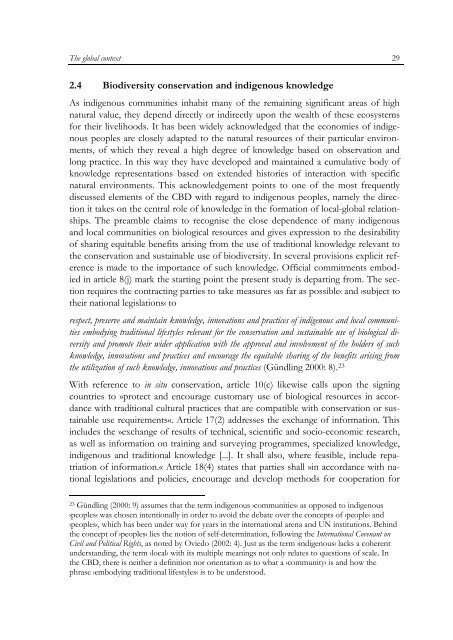The cultural context of biodiversity conservation - Oapen
The cultural context of biodiversity conservation - Oapen
The cultural context of biodiversity conservation - Oapen
You also want an ePaper? Increase the reach of your titles
YUMPU automatically turns print PDFs into web optimized ePapers that Google loves.
<strong>The</strong> global <strong>context</strong><br />
2.4 Biodiversity <strong>conservation</strong> and indigenous knowledge<br />
As indigenous communities inhabit many <strong>of</strong> the remaining significant areas <strong>of</strong> high<br />
natural value, they depend directly or indirectly upon the wealth <strong>of</strong> these ecosystems<br />
for their livelihoods. It has been widely acknowledged that the economies <strong>of</strong> indigenous<br />
peoples are closely adapted to the natural resources <strong>of</strong> their particular environments,<br />
<strong>of</strong> which they reveal a high degree <strong>of</strong> knowledge based on observation and<br />
long practice. In this way they have developed and maintained a cumulative body <strong>of</strong><br />
knowledge representations based on extended histories <strong>of</strong> interaction with specific<br />
natural environments. This acknowledgement points to one <strong>of</strong> the most frequently<br />
discussed elements <strong>of</strong> the CBD with regard to indigenous peoples, namely the direction<br />
it takes on the central role <strong>of</strong> knowledge in the formation <strong>of</strong> local-global relationships.<br />
<strong>The</strong> preamble claims to recognise the close dependence <strong>of</strong> many indigenous<br />
and local communities on biological resources and gives expression to the desirability<br />
<strong>of</strong> sharing equitable benefits arising from the use <strong>of</strong> traditional knowledge relevant to<br />
the <strong>conservation</strong> and sustainable use <strong>of</strong> <strong>biodiversity</strong>. In several provisions explicit reference<br />
is made to the importance <strong>of</strong> such knowledge. Official commitments embodied<br />
in article 8(j) mark the starting point the present study is departing from. <strong>The</strong> section<br />
requires the contracting parties to take measures ›as far as possible‹ and ›subject to<br />
their national legislations‹ to<br />
respect, preserve and maintain knowledge, innovations and practices <strong>of</strong> indigenous and local communities<br />
embodying traditional lifestyles relevant for the <strong>conservation</strong> and sustainable use <strong>of</strong> biological diversity<br />
and promote their wider application with the approval and involvement <strong>of</strong> the holders <strong>of</strong> such<br />
knowledge, innovations and practices and encourage the equitable sharing <strong>of</strong> the benefits arising from<br />
the utilization <strong>of</strong> such knowledge, innovations and practices (Gündling 2000: 8). 23<br />
With reference to in situ <strong>conservation</strong>, article 10(c) likewise calls upon the signing<br />
countries to »protect and encourage customary use <strong>of</strong> biological resources in accordance<br />
with traditional <strong>cultural</strong> practices that are compatible with <strong>conservation</strong> or sustainable<br />
use requirements«. Article 17(2) addresses the exchange <strong>of</strong> information. This<br />
includes the »exchange <strong>of</strong> results <strong>of</strong> technical, scientific and socio-economic research,<br />
as well as information on training and surveying programmes, specialized knowledge,<br />
indigenous and traditional knowledge [...]. It shall also, where feasible, include repatriation<br />
<strong>of</strong> information.« Article 18(4) states that parties shall »in accordance with national<br />
legislations and policies, encourage and develop methods for cooperation for<br />
23 Gündling (2000: 9) assumes that the term indigenous ›communities‹ as opposed to indigenous<br />
›peoples‹ was chosen intentionally in order to avoid the debate over the concepts <strong>of</strong> ›people‹ and<br />
›peoples‹, which has been under way for years in the international arena and UN institutions. Behind<br />
the concept <strong>of</strong> ›peoples‹ lies the notion <strong>of</strong> self-determination, following the International Covenant on<br />
Civil and Political Rights, as noted by Oviedo (2002: 4). Just as the term ›indigenous‹ lacks a coherent<br />
understanding, the term ›local‹ with its multiple meanings not only relates to questions <strong>of</strong> scale. In<br />
the CBD, there is neither a definition nor orientation as to what a ›community‹ is and how the<br />
phrase ›embodying traditional lifestyles‹ is to be understood.<br />
29

















